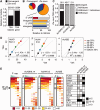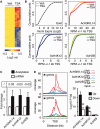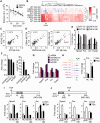Genomic targets, and histone acetylation and gene expression profiling of neural HDAC inhibition
- PMID: 23821663
- PMCID: PMC3783173
- DOI: 10.1093/nar/gkt590
Genomic targets, and histone acetylation and gene expression profiling of neural HDAC inhibition
Abstract
Histone deacetylase inhibitors (HDACis) have been shown to potentiate hippocampal-dependent memory and synaptic plasticity and to ameliorate cognitive deficits and degeneration in animal models for different neuropsychiatric conditions. However, the impact of these drugs on hippocampal histone acetylation and gene expression profiles at the genomic level, and the molecular mechanisms that underlie their specificity and beneficial effects in neural tissue, remains obscure. Here, we mapped four relevant histone marks (H3K4me3, AcH3K9,14, AcH4K12 and pan-AcH2B) in hippocampal chromatin and investigated at the whole-genome level the impact of HDAC inhibition on acetylation profiles and basal and activity-driven gene expression. HDAC inhibition caused a dramatic histone hyperacetylation that was largely restricted to active loci pre-marked with H3K4me3 and AcH3K9,14. In addition, the comparison of Chromatin immunoprecipitation sequencing and gene expression profiles indicated that Trichostatin A-induced histone hyperacetylation, like histone hypoacetylation induced by histone acetyltransferase deficiency, had a modest impact on hippocampal gene expression and did not affect the transient transcriptional response to novelty exposure. However, HDAC inhibition caused the rapid induction of a homeostatic gene program related to chromatin deacetylation. These results illuminate both the relationship between hippocampal gene expression and histone acetylation and the mechanism of action of these important neuropsychiatric drugs.
Figures







Similar articles
-
HDAC inhibition attenuates cardiac hypertrophy by acetylation and deacetylation of target genes.Epigenetics. 2015;10(5):418-30. doi: 10.1080/15592294.2015.1024406. Epub 2015 May 5. Epigenetics. 2015. PMID: 25941940 Free PMC article.
-
Histone deacetylase inhibition down-regulates cyclin D1 transcription by inhibiting nuclear factor-kappaB/p65 DNA binding.Mol Cancer Res. 2005 Feb;3(2):100-9. doi: 10.1158/1541-7786.MCR-04-0070. Mol Cancer Res. 2005. PMID: 15755876
-
Inhibition of histone deacetylases by Trichostatin A leads to a HoxB4-independent increase of hematopoietic progenitor/stem cell frequencies as a result of selective survival.Cytotherapy. 2010 Nov;12(7):899-908. doi: 10.3109/14653240903580254. Cytotherapy. 2010. PMID: 20210674
-
Histone modifications in status epilepticus induced by kainate.Histol Histopathol. 2006 Jul;21(7):785-91. doi: 10.14670/HH-21.785. Histol Histopathol. 2006. PMID: 16598677 Review.
-
Trichostatin A and trapoxin: novel chemical probes for the role of histone acetylation in chromatin structure and function.Bioessays. 1995 May;17(5):423-30. doi: 10.1002/bies.950170510. Bioessays. 1995. PMID: 7786288 Review.
Cited by
-
Effects of a histone deacetylase 3 inhibitor on extinction and reinstatement of cocaine self-administration in rats.Psychopharmacology (Berl). 2019 Jan;236(1):517-529. doi: 10.1007/s00213-018-5122-2. Epub 2018 Nov 28. Psychopharmacology (Berl). 2019. PMID: 30488346 Free PMC article.
-
The neuronal activity-driven transcriptome.Mol Neurobiol. 2015;51(3):1071-88. doi: 10.1007/s12035-014-8772-z. Epub 2014 Jun 17. Mol Neurobiol. 2015. PMID: 24935719 Review.
-
Genome-Wide Analysis Reveals Selective Modulation of microRNAs and mRNAs by Histone Deacetylase Inhibitor in B Cells Induced to Undergo Class-Switch DNA Recombination and Plasma Cell Differentiation.Front Immunol. 2015 Dec 14;6:627. doi: 10.3389/fimmu.2015.00627. eCollection 2015. Front Immunol. 2015. PMID: 26697020 Free PMC article.
-
Histone deacetylase knockouts modify transcription, CAG instability and nuclear pathology in Huntington disease mice.Elife. 2020 Sep 29;9:e55911. doi: 10.7554/eLife.55911. Elife. 2020. PMID: 32990597 Free PMC article.
-
HDAC inhibitor-dependent transcriptome and memory reinstatement in cognitive decline models.J Clin Invest. 2015 Sep;125(9):3572-84. doi: 10.1172/JCI79942. Epub 2015 Aug 17. J Clin Invest. 2015. PMID: 26280576 Free PMC article.
References
-
- Strahl BD, Allis CD. The language of covalent histone modifications. Nature. 2000;403:41–45. - PubMed
-
- Kouzarides T. Chromatin modifications and their function. Cell. 2007;128:693–705. - PubMed
-
- Alarcon JM, Malleret G, Touzani K, Vronskaya S, Ishii S, Kandel ER, Barco A. Chromatin acetylation, memory, and LTP are impaired in CBP+/− mice: a model for the cognitive deficit in Rubinstein-Taybi syndrome and its amelioration. Neuron. 2004;42:947–959. - PubMed
-
- Lopez-Atalaya JP, Gervasini C, Mottadelli F, Spena S, Piccione M, Scarano G, Selicorni A, Barco A, Larizza L. Histone acetylation deficits in lymphoblastoid cell lines from patients with Rubinstein-Taybi syndrome. J. Med. Genet. 2012;49:66–74. - PubMed
Publication types
MeSH terms
Substances
LinkOut - more resources
Full Text Sources
Other Literature Sources
Molecular Biology Databases

